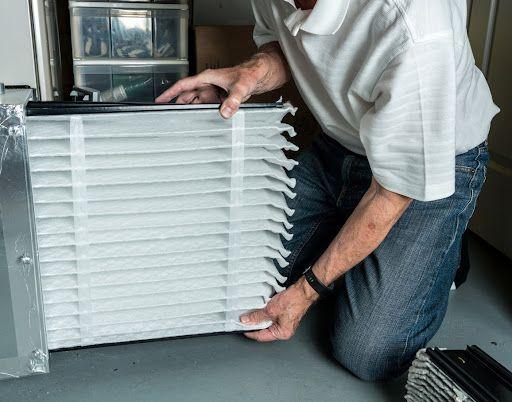Common Symptoms of a Dirty HVAC Filter

As a homeowner, maintaining the optimal functionality of your HVAC system is crucial for a comfortable living environment. One often overlooked aspect of HVAC care is replacing air filters regularly. HVAC.com shares the dirty HVAC filter symptoms you should be on the lookout for so you know when it’s time for a new one.
Understanding the Importance of Air Filters
The primary purpose of an HVAC filter is to act as a frontline defense against airborne particles, trapping dust and debris before they have the chance to infiltrate and circulate within the HVAC system and your home. By capturing particles such as dust, pet dander, pollen, and other allergens, the air filter not only ensures cleaner and healthier air but also safeguards the internal components of the HVAC system.
Clogged Furnace Filter Symptoms
- Visible Dust Around Vents: Take a moment to inspect the area around your air vents. If you notice an accumulation of dust, it’s a clear indicator that your filter is no longer effectively trapping airborne particles.
- Increased Dust in the Home: A dirty HVAC filter fails to effectively trap airborne particles, leading to an escalation in dust levels throughout the living spaces, affecting furniture, surfaces, and indoor air quality.
- Allergy or Respiratory Issues: If you or your family members are experiencing increased allergy symptoms or respiratory issues, a dirty air filter could be contributing to poor indoor air quality. Regular air filter replacement is essential for minimizing airborne allergens.
- Decreased Airflow: One of the earliest signs of a dirty AC filter in the home is a noticeable reduction in airflow. If you find that certain rooms are not receiving as much heated or cooled air as usual, a dirty filter might be to blame.
- Increased Energy Bills: A dirty furnace filter forces your HVAC system to work harder to maintain the desired temperature, leading to increased energy consumption. If you’ve noticed a spike in your energy bills, it’s worth checking and replacing your filter.
- Uneven Heating or Cooling: A clogged filter can result in uneven temperature distribution throughout your home. Some areas may feel warmer or cooler than others, indicating an imbalance in your HVAC system.
- Ice Buildup on the Evaporator Coils: An excessively dirty filter can lead to the formation of ice on the evaporator coils. This not only hinders the cooling process but can also cause long-term damage to your AC unit if left unaddressed.
- Strange Odors: A musty or moldy odor emanating from your air vents could be a sign of a dirty AC filter. As dust and debris accumulate, they provide a breeding ground for mold and bacteria, leading to unpleasant odors circulating in your home.
- HVAC System Overheating: A severely clogged filter restricts airflow, causing the HVAC system to overheat. In extreme cases, this can trigger automatic shutdowns as a protective measure, potentially leading to system malfunctions and the need for repairs.
What Does a Dirty Furnace Filter Look Like?
The frequency at which an HVAC filter should be changed depends on several factors, including the type and efficiency of the filter, the level of household contaminants, and the specific requirements of your HVAC system. As a general guideline, standard fiberglass filters typically need replacement every 1-3 months, while high-efficiency filters may last up to 6 months or even longer. However, homes with pets, allergy sufferers, or those located in areas with high pollen counts may require more frequent changes.
Identifying a dirty furnace filter is a key step in maintaining your HVAC system. In addition to the dirty AC filter symptoms mentioned above, a visual inspection of your filter can also tell you if it’s time to replace it.
The gray color is a visual indication of the collected debris, and the extent of discoloration correlates with the level of pollutants filtered out. When it’s due for replacement, you’ll notice a coating of contaminants instead of a uniform appearance.
If you’re unsure about whether the air filter is clogged, hold it up to a light source. If the filter is still in good condition, light should shine through. If the filter is dirty or clogged with debris, the light will be obstructed, indicating it’s time for a replacement.
The presence of visible mold is another one of the dirty HVAC filter symptoms that indicates it’s time for a replacement. Mold growth occurs on filters when humidity levels are high. Mold spores, naturally present in the air, can settle on the filter and find the moisture and organic matter they need to thrive. A clogged or dirty filter’s dark, damp conditions provide an ideal breeding ground for mold, compromising indoor air quality.